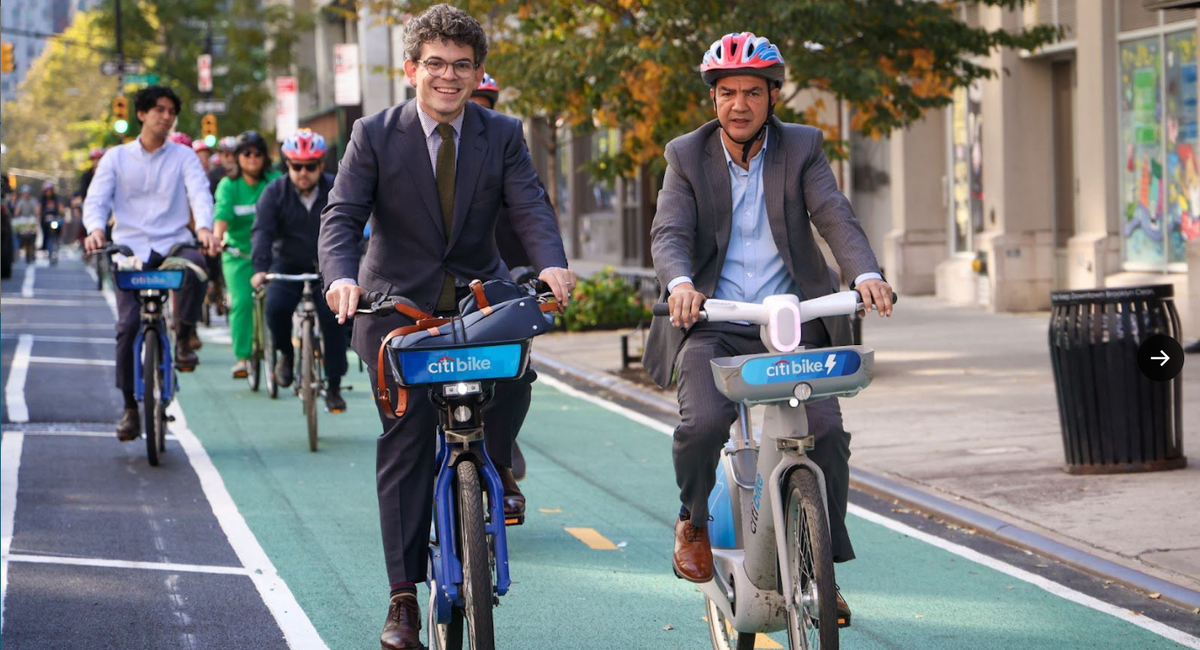This column originally appeared in On The Way, a weekly newsletter covering everything you need to know about NYC-area transportation.
Sign up to get the full version, which includes answers to reader questions, trivia, service changes and more, in your inbox every Thursday.
Electric Citi Bikes might make it easier for riders to cruise long distances without breaking a sweat — but they’re also quite pricey. The service charges a 36-cent per-minute fee to non-members who rent one of the pedal assist bikes — and 24 cents a minute for members.
City Councilmember Lincoln Restler of Brooklyn has a plan to address those fees, at least for Citi Bike members.
“The costs for riders right now are out of control,” Restler said, noting he’s taken roughly 4,500 rides as a Citi Bike member. He said he pays $10 for an e-bike ride through his district from Greenpoint to Downtown Brooklyn. That’s on top of the service’s annual membership fee, which now costs $220.
Restler said Lyft, which owns Citi Bike, has repeatedly jacked up its fares in recent years, putting the service out of reach for working-class New Yorkers. He plans to introduce legislation that would cap the e-bike fees at the cost of a subway ride for Citi Bike’s roughly 127,000 members. But the change wouldn’t take effect until the next round of contract negotiations with the city, which are currently slated for 2029.
The e-bikes are a major revenue source for Citi Bike, but Lyft representatives have also said they’re expensive to maintain. When the company hiked its e-bike fares earlier this year, it said it was due to high costs for battery swapping, insurance — and the vehicles workers use to maintain the two-wheelers.
Currently, e-bikes make up 40% of Citi Bike’s fleet in the city. But in August, 66% of all trips were made on e-bikes.
Lyft explored a sale of Citi Bike last year while the company went through rounds of layoffs, months after the company pulled the plug on its bike-sharing operation in Minneapolis.
But New York is different. The city has been described as the “crown jewel” in Lyft’s bike share empire, which includes 53 cities in 15 countries. The company reported it made roughly $24 million on Citi Bike trips during June alone.
Restler said the city government should step in and help Lyft with its e-bike operations by connecting Citi Bike docks to the electrical grid. The transportation department is currently testing out two of those electrified docks, which allow bikes to be charged where they’re stored — instead of requiring workers to drive around the city and swap out their batteries.
“What a silly system we have that’s depending on hundreds of cars and trucks going around New York City to recharge our sustainable form of transit,” Restler said.
A Citi Bike spokesperson declined to comment on Restler’s bill.
Have a question about subway cars (or literally anything else NYC-transit related)? Use this form to submit yours and we may answer it in a future newsletter! But note that Curious Commuter questions are exclusive for On The Way newsletter subscribers. Sign up for free here.
Question from Max in Manhattan
What’s the deal with the Interborough Express? Why is it going above ground near that cemetery rather than a tunnel and why light rail rather than the A division subway cars?
Answer
To answer the first part of Max’s question: The MTA is still in the early stages of environmental review for the Brooklyn-Queens light rail connection. But don’t hold your breath: The agency currently lacks money to fund the project, and officials have said they need to address a growing backlog of repair work on the MTA’s existing transit infrastructure before they can think about a whole new line.
The “cemetery” Max references is All Faiths in Ridgewood, Queens. Two years ago MTA officials said it would be too expensive to tunnel beneath the cemetery. Instead, they plan to run the light rail line on the street near Metropolitan Avenue, which could slow the line’s service due to traffic.
And as for the decision to run it as a light rail line instead of using subway cars, the answer lies in another tunnel. The MTA plans to utilize unused tubes in East New York (they appeared in the HBO show “Succession”) for the Interborough Express. Officials said those tunnels are too small for regular subway cars, and they would need to buy slightly smaller cars (like the ones used on the PATH train) in order to fit. Light rail cars, which are more widely manufactured, are an easier solution.
